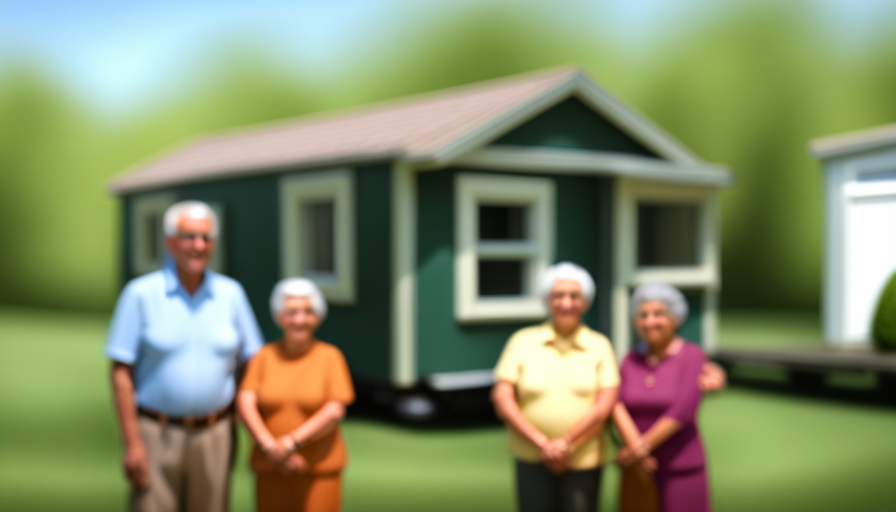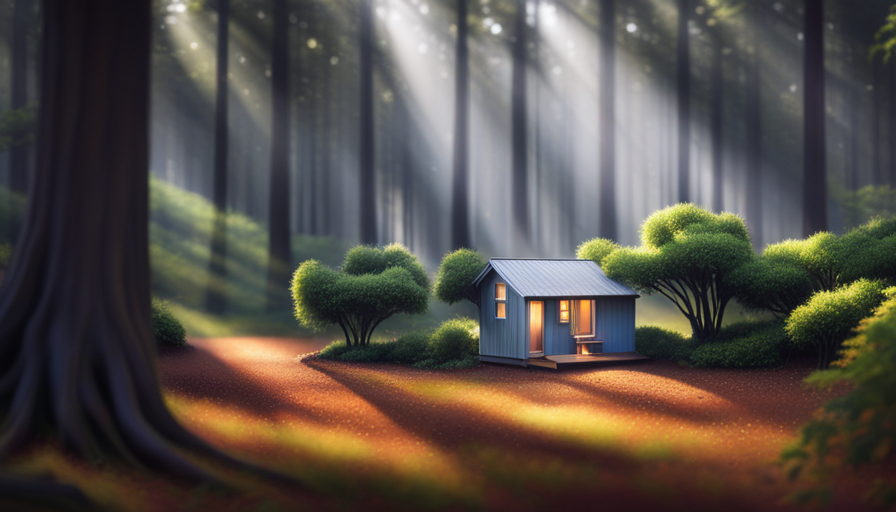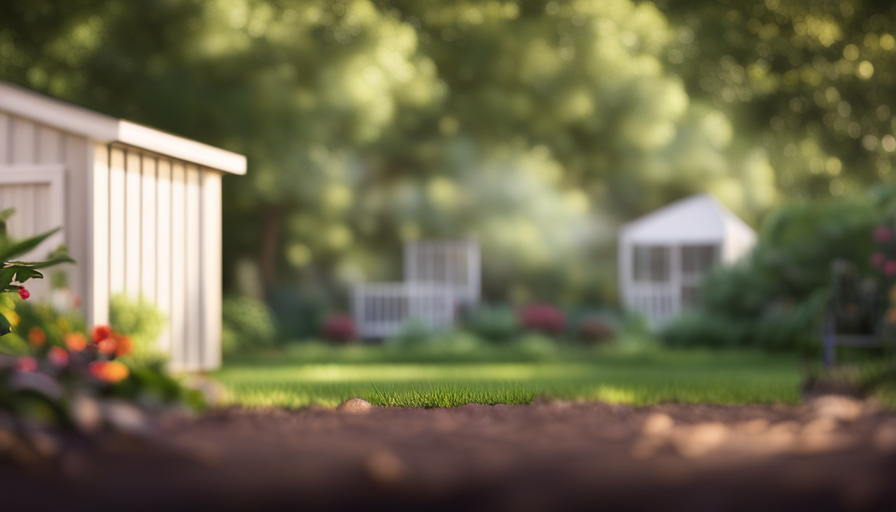I stand here, gazing at the vast horizon of possibilities, and I am amazed by the great potential that lies within a small house trailer. It may seem paradoxical, but the confined space of a tiny house trailer offers a world of opportunities for those seeking a minimalist lifestyle or a life on the go.
But how long can a tiny house trailer be? This question, my friends, is the key that unlocks the door to your dreams of freedom and mobility. In this article, we will explore the different sizes of tiny house trailers, delve into the legal requirements that govern their length, and consider the various factors to keep in mind when choosing the ideal dimensions for your tiny abode on wheels.
So, join me on this journey as we unravel the mysteries and unveil the wonders of the tiny house trailer world.
Key Takeaways
- Length of tiny house trailers can range from 12 to 32 feet.
- Zoning regulations and weight restrictions determine the maximum length of a tiny house trailer.
- Longer trailers offer more storage, design flexibility, comfortable living, outdoor living space, and future expansion opportunities.
- Challenges of longer trailers include weight distribution and the need for more powerful tow vehicles and specialized equipment.
Different Sizes of Tiny House Trailers
You won’t believe the amazing variety of sizes available for tiny house trailers! These trailers come in customizable dimensions to suit your specific needs.
Whether you’re looking for a compact option or a more spacious design, there is a trailer out there for you. The length of a tiny house trailer can range from as short as 12 feet to as long as 32 feet, providing plenty of room to create your dream tiny home.
However, it’s important to consider weight restrictions when choosing a size. Each trailer has a maximum weight capacity, and exceeding this limit can lead to safety issues on the road. It’s crucial to carefully calculate the weight of your tiny house and ensure it falls within the trailer’s guidelines.
Now that you know about the different sizes available, let’s delve into the legal requirements for tiny house trailers.
Legal Requirements for Tiny House Trailers
When it comes to the legal requirements for building a compact living space on wheels, the length of the mobile foundation plays a crucial role in determining what is permissible. Zoning regulations and weight restrictions are the two primary factors that dictate the maximum length of a tiny house trailer.
Zoning regulations vary from one jurisdiction to another and may impose limits on the size of a tiny house trailer. These regulations are typically in place to ensure that the tiny house trailer does not disrupt the aesthetic or character of a neighborhood.
Weight restrictions also come into play, as the length of the trailer impacts its overall weight. Most jurisdictions have specific weight limits that must be adhered to for safety reasons.
It is essential to research and understand the zoning regulations and weight restrictions in your area before starting the construction of a tiny house trailer. Considering these legal requirements is crucial in determining the appropriate length for your tiny house trailer.
Moving forward, let’s explore the considerations for choosing the length of a tiny house trailer.
Considerations for Choosing the Length of a Tiny House Trailer
The size of your compact mobile living space is a crucial factor to consider when selecting the perfect length for your tiny house on wheels. Tiny house trailer dimensions vary, but there are several factors to consider in choosing the length of a tiny house trailer.
To help you make an informed decision, I have created a table outlining three key considerations:
| Consideration | Description | Example |
|---|---|---|
| Lifestyle | How you plan to use your tiny house will impact the size you need. If you want a minimalist lifestyle with only the essentials, a smaller trailer may be sufficient. However, if you desire more space for amenities or plan to live with a partner or pets, a larger trailer would be more suitable. | Living alone with basic amenities versus living with a partner and pets |
| Mobility | If you intend to frequently travel with your tiny house, a shorter trailer may be more maneuverable and easier to tow. On the other hand, if you plan to stay in one location for longer periods, a longer trailer would provide more living space. | Frequent travel versus long-term stationary living |
| Legal Restrictions | It is important to research local regulations and restrictions regarding tiny house trailer lengths. Some areas may have maximum length limits that you need to adhere to. | Maximum length limit of 30 feet in a specific area |
By carefully considering these factors, you can determine the ideal length for your tiny house trailer. Longer trailers may offer additional benefits, which we will explore in the next section.
Benefits of Longer Tiny House Trailers
Having a longer trailer for your compact mobile living space provides you with more flexibility and options for designing and arranging your living area. Here are some benefits of choosing a longer tiny house trailer:
-
Maximizing storage: With a longer trailer, you have more space to incorporate clever storage solutions, such as built-in cabinets, shelves, and drawers. This allows you to effectively utilize every inch of your tiny house and keep your belongings organized.
-
Design flexibility: A longer trailer gives you the freedom to create a layout that suits your specific needs and preferences. You can have separate areas for sleeping, dining, and lounging, or even incorporate a home office or a small guest area. The extra length allows for more creativity in designing your space.
-
Comfortable living: A longer trailer can provide a more spacious and comfortable living environment. You can have larger furniture, more room to move around, and even add amenities like a full-size kitchen or a bathroom with a shower.
-
Outdoor living space: With a longer trailer, you can also have a larger outdoor living area. You can add a porch or a deck, allowing you to enjoy the outdoors and entertain guests.
-
Future expansion: If you foresee the need for additional living space in the future, a longer trailer provides the opportunity for expansion or modifications.
Transitioning into the next section about the challenges of longer tiny house trailers, it’s important to consider the potential limitations and difficulties that come with the added length.
Challenges of Longer Tiny House Trailers
Despite the allure of greater design flexibility, longer tiny house trailers can pose a double-edged sword due to the potential for increased towing difficulties. When designing the layout of a longer tiny house trailer, it’s important to consider the weight distribution to ensure safe and stable towing.
The longer the trailer, the more challenging it becomes to distribute the weight evenly, which can lead to problems such as swaying or fishtailing while on the road. This can be especially problematic when navigating tight turns or steep inclines.
In addition to weight distribution, longer trailers also require more powerful tow vehicles and specialized equipment. The increased length puts more strain on the towing vehicle’s engine and suspension, making it necessary to choose a vehicle with sufficient towing capacity. Furthermore, longer trailers may require additional safety features such as sway control systems or extended mirrors to enhance visibility.
Despite these challenges, longer tiny house trailers offer the advantage of more living space and greater design possibilities. By carefully considering weight distribution and investing in the right towing equipment, it’s possible to overcome the challenges associated with longer trailers and enjoy the benefits they provide.
In the next section, we’ll explore tips for maximizing space in a tiny house trailer, ensuring that every square inch is utilized efficiently.
Tips for Maximizing Space in a Tiny House Trailer
To make the most of your compact living space, try implementing these clever tips in your tiny home on wheels. One of the biggest challenges in a tiny house trailer is maximizing space. With limited square footage, every inch counts. One effective way to maximize space is by using space-saving furniture. Look for pieces that can serve multiple purposes, such as a sofa that can also be used as a bed or a dining table that can fold down when not in use. This allows you to have the functionality you need without taking up unnecessary space.
Another tip for maximizing space in a tiny house trailer is to utilize organization hacks. This includes using vertical space, such as installing shelves or hooks on the walls, to store items like kitchen utensils or clothing. You can also use storage containers that can fit under furniture or hang from the ceiling to make use of unused space. Additionally, consider using magnetic strips or hooks to keep small items like keys or scissors easily accessible without cluttering up countertops or drawers.
By incorporating these space-saving furniture and organization hacks, you can make the most of the limited space in your tiny house trailer. Remember, every square inch counts, so be creative and intentional in your design choices.
Frequently Asked Questions
What are the different types of materials used to build tiny house trailers?
There are various materials used to build tiny house trailers, including steel and wood. Steel offers durability and strength, making it a popular choice for those seeking a sturdy foundation for their tiny house. It is resistant to rot, pests, and fire.
On the other hand, wood provides a more traditional and natural aesthetic. However, it requires more maintenance and may be susceptible to rot and pests.
Ultimately, the choice between steel and wood depends on personal preferences and priorities.
How much weight can a tiny house trailer hold?
A tiny house trailer’s weight capacity depends on its structural integrity. The weight that a tiny house trailer can hold varies depending on factors such as the type of materials used, the trailer’s design, and its overall construction quality. It’s crucial to ensure that the trailer is built to support the intended weight of the tiny house to prevent any structural issues or potential accidents.
Are there any restrictions on parking a tiny house trailer in residential neighborhoods?
Parking a tiny house trailer in residential neighborhoods can be a complex endeavor due to parking restrictions and zoning regulations. These rules, meant to maintain order and harmony in our communities, often dictate where and how long a tiny house trailer can be parked. It’s essential to research and understand these regulations to ensure compliance and avoid any potential fines or legal issues. Consulting with local authorities or a professional in the field can provide invaluable guidance in navigating this intricate process.
Can a tiny house trailer be customized to include specific features or layouts?
Yes, a tiny house trailer can be customized to include specific features or layouts. There are various customization options available, allowing you to design the interior according to your preferences. You have the flexibility to choose the flooring material, appliances, and fixtures, creating a personalized space. Interior design plays a crucial role in optimizing the available space and creating a functional and aesthetically pleasing environment within the tiny house trailer.
Are there any specific safety regulations for tiny house trailers, such as fire safety or electrical requirements?
Fire safety regulations and electrical requirements are crucial considerations for tiny house trailers. To ensure safety, it’s important to adhere to specific guidelines.
Fire safety regulations encompass the use of flame-resistant materials, proper installation of smoke detectors, and accessible fire extinguishers.
Regarding electrical requirements, it’s essential to follow the appropriate wiring codes and standards to prevent electrical hazards.
Complying with these regulations is vital for the overall safety and well-being of occupants in tiny house trailers.
Conclusion
In conclusion, when it comes to tiny house trailers, the length is limitless! You can go as long as your imagination desires, creating a spacious and luxurious living environment.
With longer trailers, you have the freedom to design and organize your tiny house in endless ways, maximizing every inch of space. However, it’s important to remember the legal requirements and challenges that come with longer trailers.
By carefully considering these factors and implementing smart space-saving techniques, you can create the tiny house of your dreams on a grand scale.
Hi, I’m Emma. I’m the Editor in Chief of Tiny House 43, a blog all about tiny houses. While tree houses are often associated with childhood, they can be the perfect adult retreat. They offer a cozy space to relax and unwind, surrounded by nature. And since they’re typically built on stilts or raised platforms, they offer stunning views that traditional homes simply can’t match. If you’re looking for a unique and romantic getaway, a tree house tiny house might just be the perfect option.










